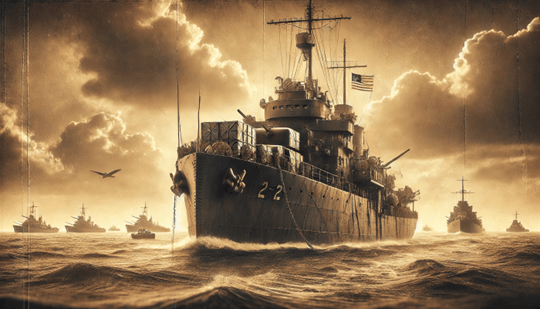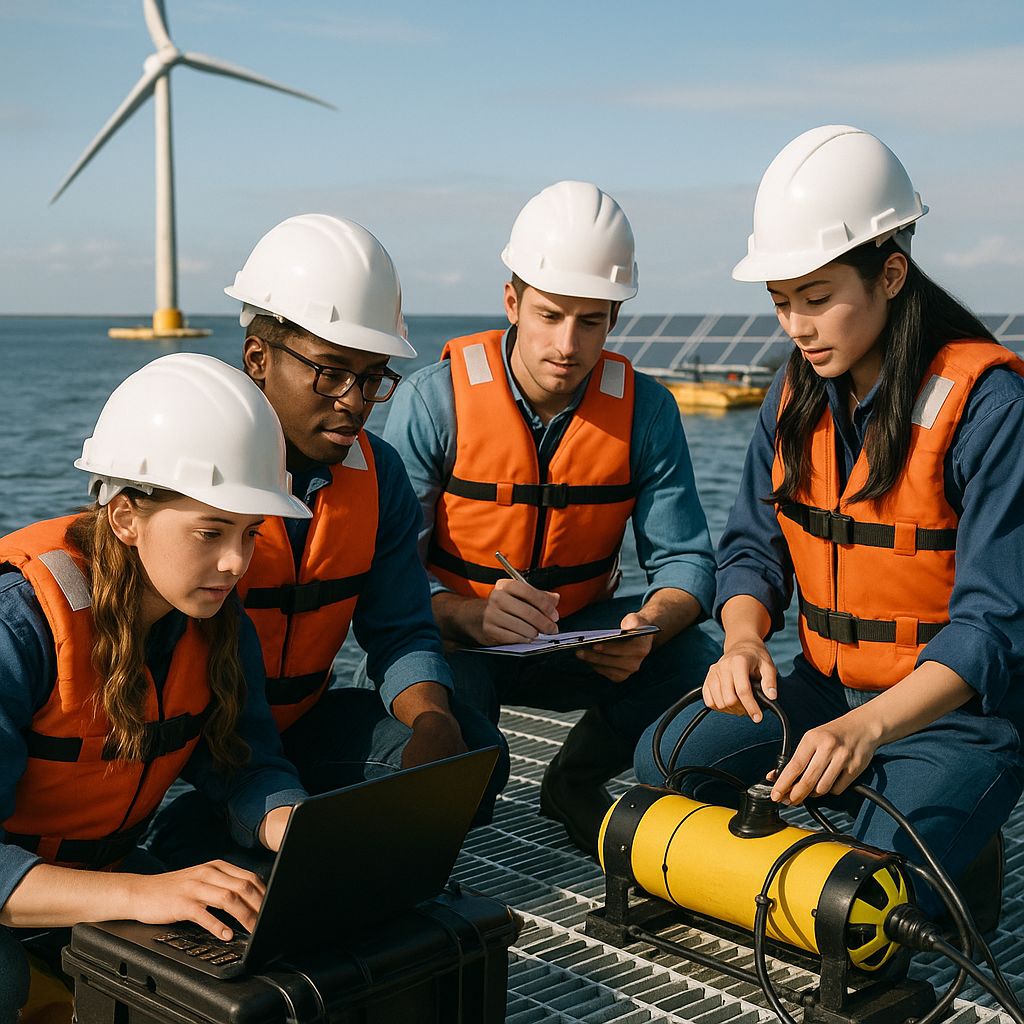
Good morning! The concept of large-scale floating infrastructure is not a new one. In fact, it has deep historical roots, stretching back to World War II, when the need for rapid production and global logistics led to the creation of the Liberty ships. These vessels were more than just cargo ships—they were floating factories that played a crucial role in the Allied war effort. Their legacy continues to influence the development of modern floating infrastructure, offering valuable lessons for today’s emerging Floating Economy. Let’s take a closer look at how Liberty ships changed global logistics and how their story is shaping the future of industries on the water.
🚢 The Liberty Ships' Legacy: Efficiency at Sea
During WWII, Liberty ships became symbols of industrial efficiency and mass production. Designed for speed and simplicity, these cargo vessels were built using prefabricated sections and welded instead of riveted, a method that dramatically sped up construction. This innovation allowed each ship to be completed in as little as 42 days, a remarkable feat for its time. Over 2,700 Liberty ships were produced, transporting critical supplies such as food, weapons, raw materials, and vehicles, ensuring that the supply lines remained intact across vast oceans during the war’s most intense periods.
Not only did these ships help carry vital cargo, but they also demonstrated the effectiveness of scaling industrial production. In a time when manufacturing was largely limited by land-based factories, the Liberty ships showed that large-scale infrastructure could be mobilized on the water, opening doors for future innovations in floating industries. Their remarkable production speed and volume directly influenced how the world would approach industrial manufacturing and logistics for decades to come.

⚓ Floating Factories for a Global Cause
The Liberty ships were more than just vessels designed to carry goods. Many were adapted into floating repair stations, troop carriers, and hospital ships, making them invaluable assets throughout the war. This versatility showed that large floating platforms could serve multiple roles, from manufacturing to providing essential services on the move. These ships demonstrated that with the right technology, infrastructure could be dynamic and adaptable to the demands of global needs, an insight that continues to drive the development of modern floating platforms in the Floating Economy.
Today, this legacy lives on as floating infrastructure is used for a variety of purposes. From offshore energy production to aquaculture platforms, floating factories are becoming essential components of industries that demand mobility, scale, and the ability to operate in challenging environments. The lessons learned from the Liberty ships continue to influence the design and development of these platforms. For businesses and governments looking to capitalize on these developments, the impact of the Liberty ships underscores the importance of innovation and flexibility in infrastructure projects.
🚢 The Floating Economy's Bright Future
Just as Liberty ships helped transform global logistics during wartime, modern floating platforms are poised to revolutionize industries in peacetime. Offshore industrial hubs, aquaculture facilities, and energy production platforms are already beginning to reshape supply chains across various sectors. With advancements in automation, robotics, and materials science, floating hubs of production and service are rapidly becoming vital pieces of global infrastructure. These innovations are not limited to just energy or food production, they are also unlocking new opportunities for businesses across industries that traditionally relied on land-based systems.
By 2045, floating platforms could become integral to global supply chains, supporting everything from renewable energy generation to sustainable food production. Offshore manufacturing and logistics hubs may become just as critical as traditional ports and warehouses. What once seemed like an unthinkable idea is now moving towards becoming a mainstream solution for businesses and industries across the globe. The legacy of the Liberty ships shows us that such large-scale, adaptable floating infrastructure is not only feasible but essential to the future of global commerce.
⚓ Business Opportunities in the Americas
The U.S. and broader Americas are increasingly focusing on revitalizing their maritime industries, particularly with initiatives launched under the Trump administration this year. These initiatives are setting the stage for a new era of shipbuilding, local manufacturing, and maritime infrastructure in the region. By focusing on bolstering domestic production capabilities, the administration is opening the door for businesses to take part in the expansion of the maritime and shipbuilding industries.
One of the major drivers of these initiatives is the emphasis on boosting local manufacturing and reviving U.S. shipyards, which were once vital to the global supply chain. The Trump administration’s efforts to invest in shipbuilding infrastructure, such as the expansion of U.S. naval shipyards and the promotion of domestic production capabilities, present major opportunities for businesses to engage in the production and maintenance of both commercial and military vessels. This push for local manufacturing not only ensures national security but also creates new opportunities for entrepreneurship and innovation in the region.
In the coming years, the Americas are set to see a surge in demand for maritime infrastructure, ranging from shipbuilding and port facilities to floating logistics hubs. Entrepreneurs and businesses in the Americas should be paying close attention to these developments. As floating infrastructure becomes more prevalent, industries in energy, logistics, and manufacturing will continue to expand, offering new revenue streams and growth opportunities.

🌊 Training, Education, and Workforce Development
The growth of the floating economy presents an immediate need for a highly skilled workforce. As industries such as offshore energy, shipbuilding, and floating logistics expand, there is a growing demand for trained professionals who can design, build, operate, and maintain floating infrastructure. From shipbuilders and maritime engineers to offshore technicians and project managers, specialized talent will be required at every level of these industries.
This need presents a significant opportunity for educational institutions, businesses, and government agencies to collaborate in developing training programs, certifications, and workforce pipelines. As the floating economy grows, so will the demand for training initiatives that can provide technical and managerial skills tailored to the unique challenges of waterborne industries. Workforce development will be key to ensuring that these industries have the skilled labor necessary to thrive.
Across the Americas, there are vast opportunities to invest in workforce initiatives aimed at addressing these needs. Universities, trade schools, and vocational programs are in high demand to provide hands-on training for these specialized industries. Entrepreneurs and institutions that focus on building these educational pathways will play a critical role in fueling the growth of the floating economy.
💼 The Growing Floating Economy Market
As floating infrastructure technology continues to advance, the market for waterborne industrial hubs is projected to grow substantially. By 2045, floating platforms could support everything from industrial manufacturing to renewable energy generation, becoming key components of global supply chains. This transformation will be driven by both technological advancements and the increasing need for scalable, mobile infrastructure solutions.
The global floating infrastructure market is expected to reach a valuation of $10 billion by 2030, with strong demand across multiple sectors. This projected growth represents a huge opportunity for businesses, entrepreneurs, and investors alike. The continued development of these platforms will help shape the future of global commerce, providing a critical infrastructure backbone to industries as diverse as energy, logistics, and aquaculture.
🚢 Around the World: Companies Leading the Charge
Leading companies in the Americas are already pioneering the future of floating infrastructure. With the renewed focus on shipbuilding and maritime manufacturing, U.S. shipyards are being revitalized, and companies are positioning themselves to lead in the development of floating logistics hubs, offshore energy production, and water-based industrial manufacturing.
These efforts are largely backed by government initiatives designed to stimulate local manufacturing and maritime innovation, offering a significant advantage to companies that are prepared to scale quickly and tap into this growing market. Businesses in the Americas are well-positioned to drive the next wave of floating infrastructure development, from modular shipbuilding to floating energy platforms. This is the time for entrepreneurs to take a leap into the floating economy and capitalize on these developments.

🌍 Newsworthy Number
$10B: The Projected Market Size of Floating Infrastructure by 2030
This market is rapidly gaining momentum, as nations and industries worldwide invest heavily in water-based infrastructure. Entrepreneurs and investors have an incredible opportunity to capitalize on this growth by positioning themselves early in the development of this emerging market. The Liberty ships of the past proved the potential of waterborne infrastructure; it’s now time to take those lessons and apply them to the growing floating economy.
📈 The Big Picture
The legacy of Liberty ships teaches us that floating infrastructure is more than just a historical curiosity. It represents the future of global commerce and innovation. Whether it’s energy production, offshore logistics, or new manufacturing solutions, floating platforms are poised to change the way industries operate on the water. Just as Liberty ships powered the global supply chain during wartime, today’s floating economy is set to support the next wave of industrial revolution on the world’s waterways.
💡 What opportunities are you seeing in the floating economy?
Do you think floating infrastructure will reshape global industries as much as Liberty ships did? How are you preparing to capitalize on the rise of waterborne industries?
The Floating Institute is building towards the future through our training and education initiatives. If you'd like to learn more, please reach out.
